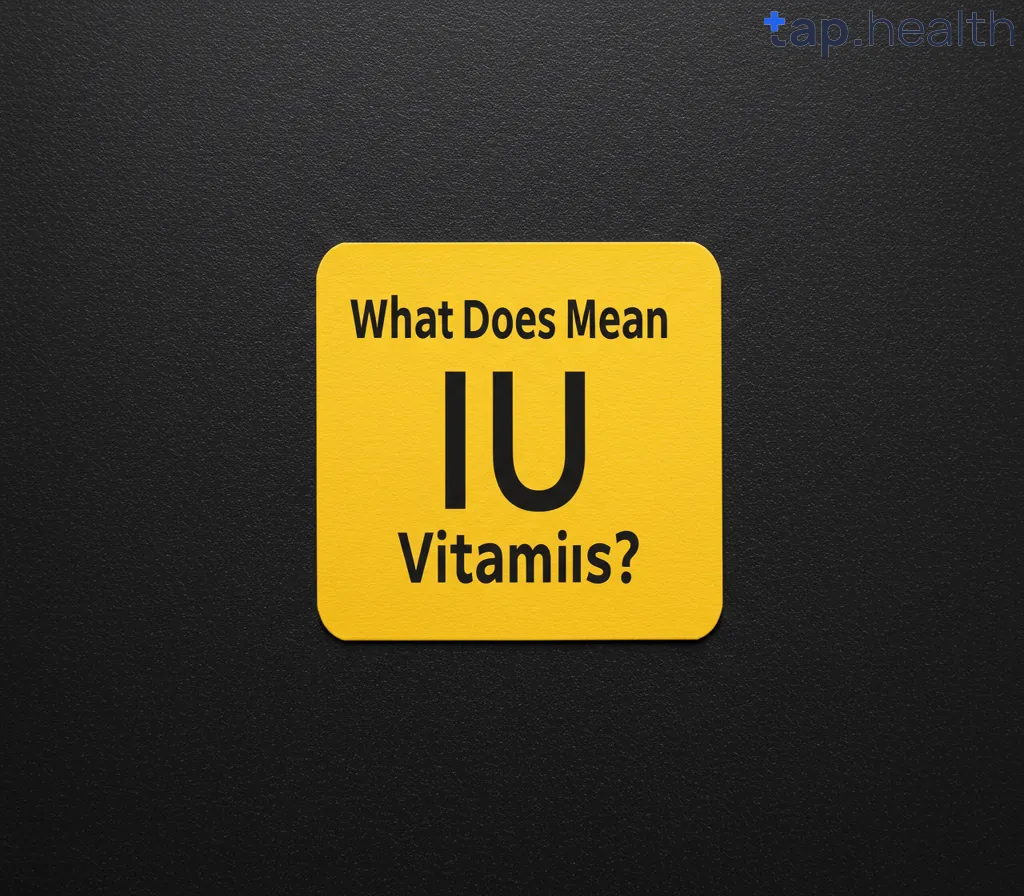If you’ve ever picked up a bottle of vitamin D, A, or E and seen the label say “2000 IU” — you’ve probably wondered: What does IU mean with vitamins?
You’re not alone. “IU” is one of the most confusing things on supplement labels. It’s not a number you use every day like grams or ounces. It doesn’t tell you weight. It’s not even a word.
So what is it?
And more importantly — does it matter how much you’re taking?
Yes. It matters a lot.
In this guide, we’ll break down exactly what IU means, why some vitamins use it instead of milligrams (mg), and how to make sure you’re getting the right amount — not too little, not too much.
We’ll keep it simple. No medical jargon. No confusing math. Just clear, easy-to-understand facts — backed by trusted health sources like the National Institutes of Health (NIH), Mayo Clinic, Harvard Health, and the Office of Dietary Supplements.
Let’s start at the beginning.
What Does IU Stand For?
IU stands for “International Unit.”
It’s a way to measure the effectiveness or biological activity of certain vitamins and other substances — especially fat-soluble ones like vitamins A, D, and E.
But here’s the key:
An IU is not a measure of weight like milligrams (mg) or micrograms (mcg). Instead, it measures how strong or active a vitamin is in your body.
Think of it like this:
- If you’re measuring sugar, you might use grams — because you care about how much there is.
- But if you’re measuring a painkiller, you might care more about how strong it is — not just how much you’re taking.
That’s what IU does. It tells you how much biological effect you’re getting from a vitamin.
Why Use IU Instead of Milligrams?
Because not all forms of a vitamin are equally powerful.
For example:
- Two different types of vitamin D might weigh the same (say, 10 mcg), but one might be more effective in your body than the other.
- So, scientists use IU to standardize the strength — so you know you’re getting the same effect every time, no matter the brand or form.
This is especially important for vitamins that come in different forms and have different potencies.
Which Vitamins Use IU?
Not all vitamins are measured in IUs. Only certain fat-soluble vitamins use this system because their activity can vary a lot depending on the form.
The main vitamins measured in IU are:
| Vitamin A | ✅ Yes | Different forms (retinol, beta-carotene) have different strengths |
| Vitamin D | ✅ Yes | D2 and D3 have different effectiveness; IU standardizes potency |
| Vitamin E | ✅ Yes | Natural and synthetic forms differ in activity |
| Vitamin C | ❌ No | Measured in mg — all forms are similar in effect |
| B Vitamins | ❌ No | Measured in mg or mcg — water-soluble and consistent |
So if you see “IU” on a label, it’s most likely for vitamin A, D, or E.
What About Other Substances?
IU isn’t just for vitamins. It’s also used for:
- Hormones (like insulin)
- Vaccines
- Some medications (like penicillin in the past)
But for everyday people, you’ll mostly see IU on vitamin supplements.
How Is IU Different from Milligrams (mg) and Micrograms (mcg)?
This is where things get tricky.
Let’s compare:
| Milligram (mg) | Weight — 1/1000 of a gram | Most vitamins and minerals (like vitamin C, calcium) |
| Microgram (mcg) | Weight — 1/1,000,000 of a gram | B12, folic acid, small-dose nutrients |
| IU (International Unit) | Biological effect — not weight | Vitamins A, D, E |
So:
- mg and mcg tell you how much of a substance is in the pill.
- IU tells you how strong it is in your body.
They’re not the same — and you can’t convert between them in your head. You need a conversion chart.
Why Can’t You Just Use Milligrams for Everything?
Because the same weight of two different forms of a vitamin can have very different effects.
For example:
- Synthetic vitamin E is less active than natural vitamin E.
- So, 1 mg of natural E does more in your body than 1 mg of synthetic E.
To make things fair and safe, scientists use IU to say: “This amount will give you the same biological effect — no matter which form you take.”
It’s like having a universal language for vitamin strength.
How Do You Convert IU to Milligrams (or Micrograms)?
You can’t use a single formula. The conversion depends on the vitamin.
Here are the most common conversions — based on NIH and FDA guidelines:
✅ Vitamin A
| Retinol (animal form) | 1 IU = 0.3 mcg |
| Beta-carotene (plant form) | 1 IU = 0.6 mcg (less active) |
Example:
3,000 IU of retinol = 900 mcg (0.9 mg)
✅ Vitamin D
| Vitamin D2 or D3 | 1 IU = 0.025 mcg |
Example:
1,000 IU of vitamin D = 25 mcg
✅ Vitamin E
| Natural (d-alpha-tocopherol) | 1 IU = 0.67 mg |
| Synthetic (dl-alpha-tocopherol) | 1 IU = 0.45 mg |
Example:
400 IU of natural vitamin E = about 268 mg
💡 Tip: Always check the form of the vitamin on the label. Natural vitamin E is stronger than synthetic.
Why Are Conversions Important?
Because some labels list both IU and mg — but many only use IU.
If you’re comparing products or tracking your intake, you need to know how much you’re actually getting.
Also, too much of certain vitamins (especially A and D) can be harmful. Knowing the real amount helps you stay safe.
What Are the Daily Recommended Amounts in IU?
The amount of IU you need depends on your age, sex, and health.
Here’s what the National Institutes of Health (NIH) recommends for healthy adults:
| Vitamin A | 3,000 IU (men), 2,300 IU (women) |
| Vitamin D | 600–800 IU (adults up to 70), 800 IU (71+) |
| Vitamin E | 22.4 IU (natural), 33 IU (synthetic) |
Note: These are general guidelines. Some people may need more — especially if they’re deficient or have certain conditions.
Upper Safe Limits (Too Much Can Be Dangerous)
While vitamins are good for you, too much of fat-soluble vitamins can build up in your body and cause problems.
Here are the safe upper limits per day:
| Vitamin A | 10,000 IU | Liver damage, birth defects, bone issues |
| Vitamin D | 4,000 IU | High calcium, kidney stones, nausea |
| Vitamin E | 1,500 IU (natural), 1,100 IU (synthetic) | Bleeding risk, especially if on blood thinners |
⚠️ Warning: Don’t take high-dose supplements without talking to your doctor.
Why Do Some Labels Use IU and Others Use mcg?
It depends on the country, the brand, and the type of vitamin.
- In the U.S., many supplements still use IU for A, D, and E.
- In Europe and some newer labels, you may see mcg or mg instead.
- Some bottles list both — like “2000 IU (50 mcg)” — to make it easier to understand.
If you see only IU, don’t worry. You can use the conversion charts above to figure out the weight.
Is IU the Same for Everyone?
Yes — that’s the whole point.
An International Unit is standardized worldwide. That means:
- 1 IU of vitamin D in the U.S. = 1 IU in Canada, Germany, or Japan.
- It’s tested and agreed upon by international scientific groups.
So no matter where you buy your vitamins, “1000 IU” means the same biological effect.
Common Misunderstandings About IU
Let’s clear up some myths.
❌ Myth 1: “IU means ‘International Use’ or ‘Immediate Use’”
Nope. It’s International Unit — a scientific term for measuring biological activity.
❌ Myth 2: “More IU means better”
Not always. Taking more than you need doesn’t give you extra benefits — and can be dangerous.
For example, 50,000 IU of vitamin A daily can cause liver damage. More is not better.
❌ Myth 3: “If my urine is yellow, I’m getting too much”
That’s usually from B vitamins, not A, D, or E. Fat-soluble vitamins don’t color your pee. Your body stores them or removes them quietly.
❌ Myth 4: “IU and mg are the same thing”
No. They measure different things. Never assume 1 IU = 1 mg. Always convert properly.
When Should You Pay Attention to IU?
You should care about IU if you’re taking:
1. Vitamin D Supplements
Very common — especially in winter or for people with low sun exposure.
Many people take 1,000 to 5,000 IU daily. But above 4,000 IU long-term should only be done under a doctor’s supervision.
2. High-Dose Vitamin A (Like Retinol)
Found in some skin supplements or cod liver oil.
Too much retinol (not beta-carotene) can be toxic. Always check the IU.
3. Vitamin E for Heart or Skin Health
Some people take high-dose E for antioxidant benefits. But over 1,000 IU may increase bleeding risk.
4. Prenatal Vitamins
These often contain vitamin A. Pregnant women should not exceed 10,000 IU of preformed vitamin A (retinol), as it can harm the baby.
How to Read a Vitamin Label with IU
Let’s look at a real example:
Vitamin D3
Amount per serving: 2,000 IU (50 mcg)
% Daily Value: 500%
What does this mean?
- 2,000 IU = the strength of the vitamin.
- (50 mcg) = the actual weight — helpful for conversion.
- 500% Daily Value = this is 5 times the recommended daily amount.
Is that safe?
For most adults, 2,000 IU of vitamin D is safe and often recommended — especially in winter. But always talk to your doctor if you’re unsure.
Can You Take Too Little IU?
Yes — and that’s a problem too.
Not getting enough of certain vitamins can lead to health issues.
Vitamin D Deficiency
- Causes weak bones
- Increases risk of fractures
- Linked to fatigue, depression, and weak immunity
Many people don’t get enough sun or food sources, so supplements help.
Vitamin A Deficiency
- Causes night blindness
- Weakens immunity
- Dry skin and eyes
Common in areas with poor nutrition.
Vitamin E Deficiency
- Rare, but can cause nerve damage
- Muscle weakness
- Vision problems
Most people get enough from diet — nuts, seeds, and oils.
Does Natural vs. Synthetic Affect IU?
Yes — especially for vitamin E.
- Natural vitamin E (d-alpha-tocopherol) is more active.
- Synthetic (dl-alpha-tocopherol) is about 50% less effective.
So:
- 100 IU of natural E = more benefit than 100 IU of synthetic E.
But the label might not make this clear. Always check the form.
For vitamin A and D, the difference is smaller — but still considered in IU measurements.
Should You Choose Supplements with IU or mg?
It doesn’t matter — as long as you understand what you’re taking.
Best practice:
- Look for labels that list both IU and mg/mcg.
- Use conversion charts if only one is listed.
- Stick to trusted brands that follow FDA or international standards.
And remember: IU is not a bad thing — it’s actually more accurate for certain vitamins.
What If You’re Taking Multiple Supplements?
Be careful.
You might be getting vitamin D from:
- A multivitamin (400 IU)
- A separate D3 pill (2,000 IU)
- Fortified milk or cereal
Add them up.
If your total goes over 4,000 IU per day, you could be at risk — especially if you’re not deficient.
Same for vitamin A — if you eat liver weekly and take a supplement, you could go over the safe limit.
Tip: Keep a log of all your supplements and talk to your doctor during checkups.
How Do Doctors Test Vitamin Levels?
They don’t measure IU in your blood.
Instead, they use blood tests that show the actual amount of vitamin in your system — usually in nanograms per milliliter (ng/mL).
For example:
- Vitamin D is tested as 25-hydroxyvitamin D.
- A level below 20 ng/mL = deficient.
- 20–50 ng/mL = adequate.
- Above 50 ng/mL = possibly too high.
Your doctor uses this to decide if you need more — or less — supplementation.
Does Cooking or Storage Affect IU?
Yes — some vitamins lose potency over time or when exposed to heat, light, or air.
- Vitamin A: Sensitive to light and heat. Cooking can reduce it slightly.
- Vitamin D: Stable in cooking, but degrades in sunlight.
- Vitamin E: Sensitive to heat and oxygen.
Supplement bottles are designed to protect the IU value — that’s why they’re often in dark glass or opaque bottles.
And they have expiration dates — because over time, the IU can drop.
Never take expired vitamins — they may not give you the full amount listed.
Are Gummy Vitamins Measured in IU Too?
Yes. Many gummy vitamins for vitamin D or A list IU.
But be careful:
- Some gummies contain less than the label claims.
- They may not be as well-regulated as tablets.
Choose reputable brands and store them properly (not in hot cars or humid bathrooms).
Can Children Take Vitamins with IU?
Yes — but the dose matters.
Kids need less than adults.
Here’s what NIH recommends:
| 0–6 months | 400 IU | 1,350 IU |
| 7–12 months | 400 IU | 1,500 IU |
| 1–3 years | 600 IU | 2,000 IU |
| 4–8 years | 600 IU | 2,500 IU |
Many kids’ multivitamins contain 1,000 IU of vitamin D — which is higher than needed for young kids.
Always check the label. Too much vitamin A or D can be harmful to children.
What About Pregnant Women?
They need to be extra careful — especially with vitamin A.
- Beta-carotene (plant form) is safe.
- Preformed vitamin A (retinol) in high doses can cause birth defects.
Pregnant women should:
- Avoid supplements with more than 10,000 IU of preformed A.
- Get vitamin A from food (carrots, sweet potatoes).
- Take prenatal vitamins as directed.
Vitamin D is important during pregnancy — 600 IU is standard, but some need more.
Summary: What Does IU Mean With Vitamins?
Let’s bring it all together.
- IU stands for International Unit — a way to measure the strength or effect of certain vitamins.
- It’s used for vitamins A, D, and E because their activity varies by form.
- IU is not weight — it’s about biological activity.
- You can convert IU to mg or mcg using standard charts.
- Too much (especially A and D) can be harmful.
- Too little can lead to deficiency and health problems.
- Always read labels, check forms, and talk to your doctor if you’re unsure.
So the next time you see “2000 IU” on a bottle — you’ll know exactly what it means.
And you’ll know whether that amount is right for you.
FAQ: Your Top Questions About IU and Vitamins
Q1: What does IU mean in vitamins?
IU stands for International Unit. It measures the biological activity or effectiveness of certain vitamins — especially A, D, and E — rather than their weight.
Q2: Is IU the same as mg?
No. IU measures activity, while mg measures weight. They are not interchangeable. You need a conversion chart to switch between them.
Q3: How much is 1000 IU in mg?
It depends on the vitamin:
- Vitamin D: 1,000 IU = 25 mcg (0.025 mg)
- Vitamin A (retinol): 1,000 IU = 300 mcg (0.3 mg)
- Vitamin E (natural): 1,000 IU ≈ 670 mg
Q4: Why do some vitamins use IU and others use mg?
IU is used for vitamins whose effectiveness varies by form (like A, D, E). Mg is used for vitamins with consistent activity (like C and B vitamins).
Q5: Is 5000 IU of vitamin D safe?
For most adults, 5,000 IU daily is safe short-term, but long-term use should be monitored by a doctor. The upper limit is 4,000 IU/day for adults unless prescribed.
Q6: Can you overdose on vitamin A in IU?
Yes. More than 10,000 IU of preformed vitamin A (retinol) daily can lead to liver damage, birth defects, and bone problems.
Q7: Does vitamin B use IU?
No. B vitamins are water-soluble and measured in mg or mcg, not IU.
Q8: Why is vitamin D measured in IU?
Because different forms (D2 and D3) have different potencies. IU standardizes the biological effect so you get consistent results.
Q9: How do I convert IU to mcg for vitamin D?
Use this formula:
IU ÷ 40 = mcg
Or IU × 0.025 = mcg
Example: 2,000 IU = 50 mcg
Q10: Are higher IU vitamins better?
Not necessarily. More isn’t always better. Stick to recommended amounts unless your doctor says otherwise.
Q11: Do expiration dates affect IU?
Yes. Over time, vitamins lose potency. An expired supplement may deliver less than the IU listed on the label.
Q12: Can I get enough vitamin D from sunlight instead of IU supplements?
Yes — 10–30 minutes of midday sun a few times a week can make thousands of IU of vitamin D. But this depends on skin tone, location, season, and sunscreen use.
Q13: Is natural vitamin E stronger in IU?
Yes. Natural vitamin E (d-alpha-tocopherol) has higher biological activity than synthetic (dl-alpha-tocopherol). So 100 IU of natural E gives more benefit.
Q14: Should I worry about IU in multivitamins?
Only if the amounts are very high. Most multivitamins stay within safe limits. Check the label and compare to daily recommendations.
Final Thoughts: Don’t Fear the IU
“IU” might look like alphabet soup at first.
But now you know: it’s just a smart way to measure how strong a vitamin is — not how heavy it is.
Understanding IU helps you:
- Choose the right supplements
- Avoid taking too much
- Get the full benefits without risks
So the next time you see “400 IU” or “5000 IU” on a bottle — take a breath, check the chart, and make an informed choice.
Your body will thank you.



